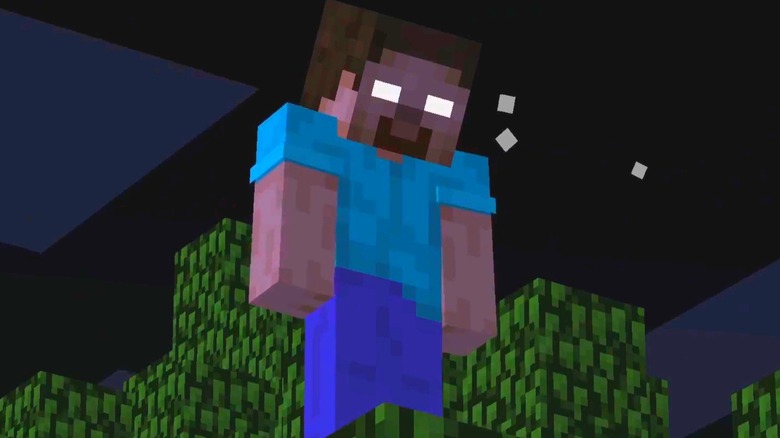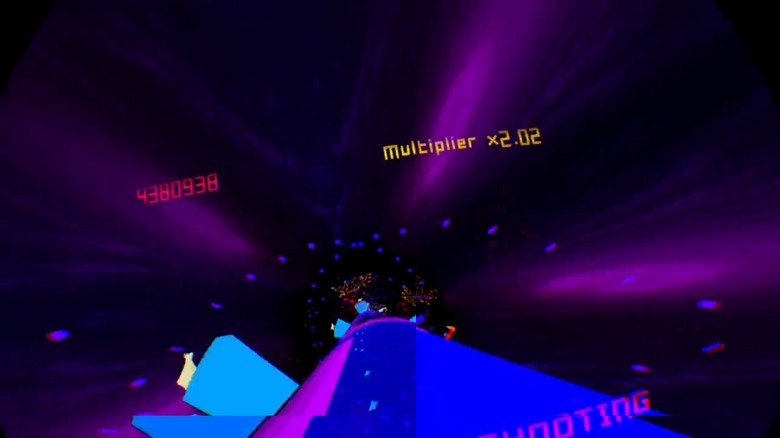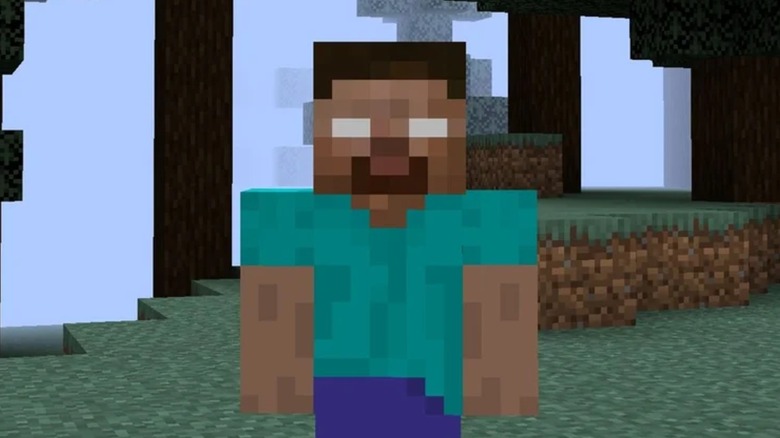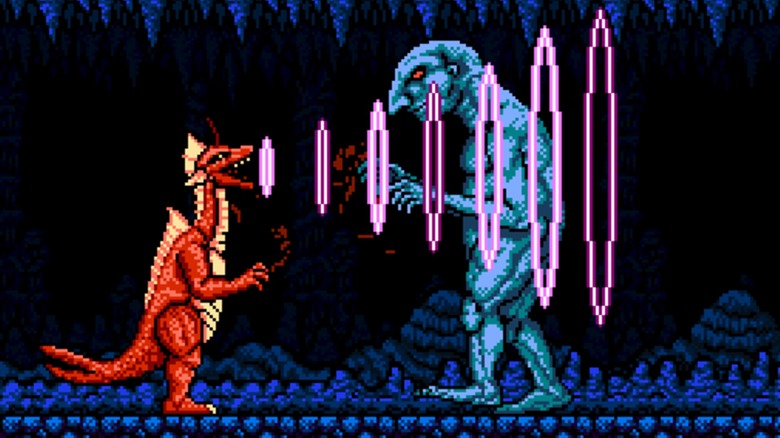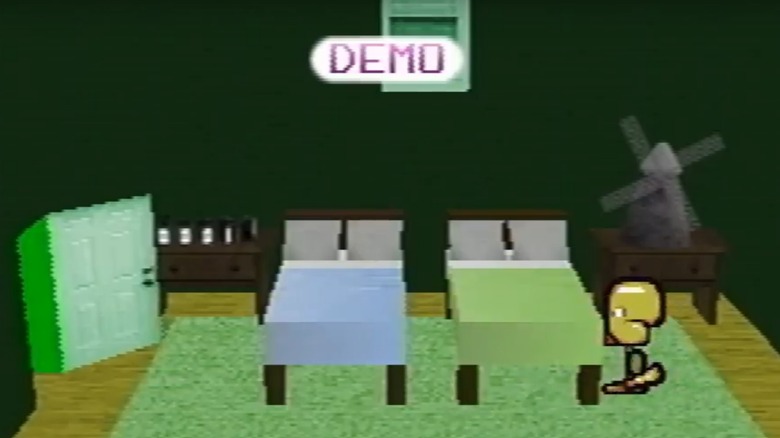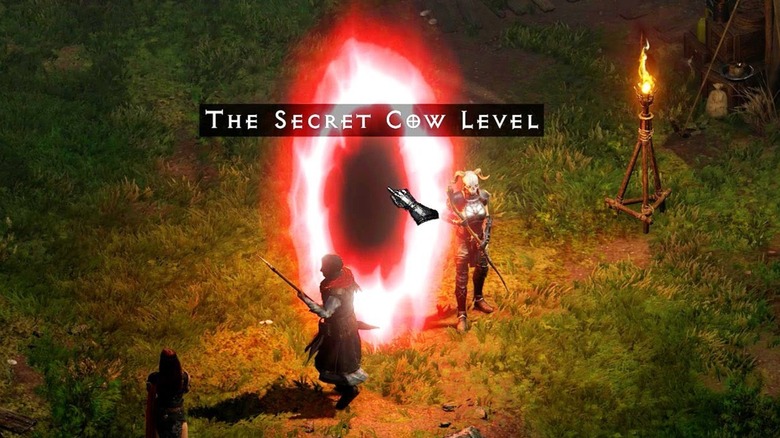Fake Video Game Urban Legends That Became Real
Developers typically feel like they know what kind of story they're telling when making a new game. After release, however, every game takes on a life of its own. Once players get their hands on a controller, the new fans will come up with stories that the original creators could never have imagined. Gaming communities love to share secrets and alternate theories — and sometimes they even develop myths about video games that spread far and wide online.
Some major viral gaming stories have turned out to be fake, but that's not what we're concerned with today. Every once in a while, a gaming urban legend or creepypasta becomes so compelling that it creates a brand new game. Fans can become so inspired by a story they saw online that they make it into a reality, or developers are amused enough by a particular rumor that they decide to include it in their next game. Here are our some of our favorite gaming myths that have become real playable experiences.
Polybius: The original video game urban legend
"Polybius" has long been shrouded in mystery. Supposedly, it once existed as an arcade cabinet released exclusively in Portland, Oregon, in the early 1980s. Some tellings say "Polybius" played like a typical arcade shooter, but everyone who played it then experienced bizarre psychological symptoms including lost memories and horrific nightmares. Rumor had it that "Polybius" was actually a government experiment deployed to test the minds of vulnerable young arcade-goers. Stories of "Polybius" have proliferated online for decades, becoming well-known enough to get a cameo in an episode of "The Simposons," but no one was ever able to find one of the legendary arcade cabinets out in the wild.
That's probably because those cabinets never existed (or the government's secret game development department is just unbelievably good at keeping secrets). No one saw a "real" version of "Polybius" until 2016, when developer Jeff Minter partnered with Sony to create a version of the game exclusive to PlayStation VR. In a PlayStation blog post, Minter kept the urban legend alive by claiming that he'd been shown a "Polybius" arcade cabinet at a retro game show and had been so affected by his short experience playing the game that he decided to create his own version of it. As far as we know, Minter's "Polybius" was not created for the purpose of manipulating anyone's brain, but play it at your own risk.
Herobrine still haunts Minecraft
"Minecraft" fans have been sharing the legend of Herobrine with each other for well over a decade. Even if you don't spend much time in "Minecraft" circles, you might have heard his name whispered or read it in a creepy story online. Herobrine is a white-eyed doppelgänger of "Minecraft" protagonist Steve who supposedly wanders the landscapes of various "Minecraft" worlds, stalking players for unknown purposes. One particularly unsettling urban legend states that Herobrine is actually the ghost of "Minecraft" creator Notch's brother, somehow haunting the game.
In vanilla "Minecraft," Herobrine is thankfully nothing but an urban legend. After checking out trailers for the "Minecraft" movie, some fans became hopeful that Jason Momoa might secretly be playing Herobrine as the film's main villain, but in the game itself, fans have had to create their own mods to get the true Herobrine experience. A popular mod called "From the Fog" makes the spooky figure follow your player around at night. Here, he'll often stay just a few steps behind you, waiting for the perfect opportunity for a jump scare. Like in the legend, the modded Herobrine usually just tries to freak you out, but he can disrupt your game, with optional settings letting him go as far as destroying your house or crashing the game completely. This is just one of the many attempts by fans to make the creepiest "Minecraft" myth into a reality, but many point to "From the Fog" as the scariest.
Pokémon: Lost Silver makes you wish you never caught 'em all
"Pokémon: Lost Silver" transforms the cute, nostalgia-infused world of retro "Pokémon" video games into the setting of a deeply unnerving horror story. "Lost Silver" began as a gaming creepypasta, and the original short story can still be found floating around on the internet today. In the story, the narrator buys a used copy of "Pokémon Silver" and finds an old save for a character they call Gold. Not long after loading up the save, the narrator realizes that something is wrong with the game. NPCs and Pokémon aren't behaving normally, the game is more violent than normal, and some Unown Pokémon seem to be spelling out an alarming message.
By the end of the story, the playthrough tells the tale of a Pokémon trainer who died and was forgotten by the rest of the world. It's a subtly spooky tale that becomes even more chilling when you play through the narrative yourself. And yes, that's an option, because a dedicated fan created their very own version of "Pokémon: Lost Silver." The fan-made game lets you play through the entire creepypasta, and true completionists can even dig a little deeper to unlock some secret endings that weren't part of the original story.
Godzilla Creepypasta is a genuinely great indie game
This is the story of yet another gaming creepypasta that made the transition from scary urban legend to completely playable reality. The original story focused on someone picking up an old copy of the 1988 game "Godzilla: Monster of Monsters" for the NES (no, that title is not a typo). They were initially excited to dive back into the nostalgic game they remembered from their childhood, but — as these things tend to go — once they got the game up and running, they noticed some serious changes. As the story unfolds, the protagonist encounters monsters that never existed in the "Godzilla" game from 1988. These new monsters have some supernatural implications, including a connection to a dead loved one from the narrator's past.
This story was ready-made for a fan game, and the internet did not disappoint. "Godzilla Creepypasta" is almost like two games in one. It works as a well-made revamp of the original NES game, showing off 2D Godzilla in full 60 FPS glory, but it also incorporates all the new monsters and secret locations that were featured in the story. The creepypasta is fairly long, so it has plenty of material to use as fodder for an entire game. This is one case where an urban legend led to another impressive piece of art.
Giftscop makes Petscop a reality
"Petscop" is a YouTube series that has all the elements of a top-tier creepypasta. The main character is a man named Paul, who gets a copy of an unreleased game called "Petscop" and starts exploring it in his free time. The series takes the form of a "let's play" channel, which tricked many viewers into believing that the game being played was a real obscure title. The game involves collecting pets and solving puzzles, but it quickly becomes obvious to Paul that it was never finished and huge chunks of content are missing. Paul eventually stumbles into a secret area called Newmaker Plane and uncovers a much darker truth beneath the surface of the game.
Fans responded to the excellent web series by recreating the game at the heart of the story. "Giftscop" is the fan-created version of the game, and the devs who worked on it envisioned that it would be a great supplement for someone who already watched the series. The goal was to be accurate to the original story above all else, which led to a pretty amusing disclaimer being added to the game's webpage: "We do not consider whether this will result in something that is fun to play, as it is irrelevant to our goal." Unlike some of the other games on this list, "Giftscop" probably isn't a great time if you're unfamiliar with the source material. For fans of the series, however, this is an excellent way to wrap up a re-watch.
The Cow Level
Most of the games on this list were created by fans who got inspired by hearing an urban legend online. However, fans aren't the only ones who like to dig into weird stories and fan theories. Back when the first "Diablo" was all the rage, some fans online started a rumor that the game contained a secret "cow level" that could be unlocked by clicking on the right cow an undisclosed number of times. The rumor spread far and wide, to the point that Blizzard eventually made the phrase "There is no cow level" an actual cheat code in "Starcraft." Despite that, some fans still believed the level must exist.
Well, they were wrong. The truth about the cow level is that it was nothing more than a rumor — in the first "Diablo," at least. The devs at Blizzard were so amused with the community's attachment to the urban legend that they decided to make the cow level a reality in "Diablo 2." The real secret cow level became one of the most iconic parts of "Diablo 2," though the process of unlocking it was anything but easy. This was not only a great gift to the fans, but it gave gamers hope that other gaming myths could somehow turn out to be true. Maybe that rare Mew really is hiding under a truck!

